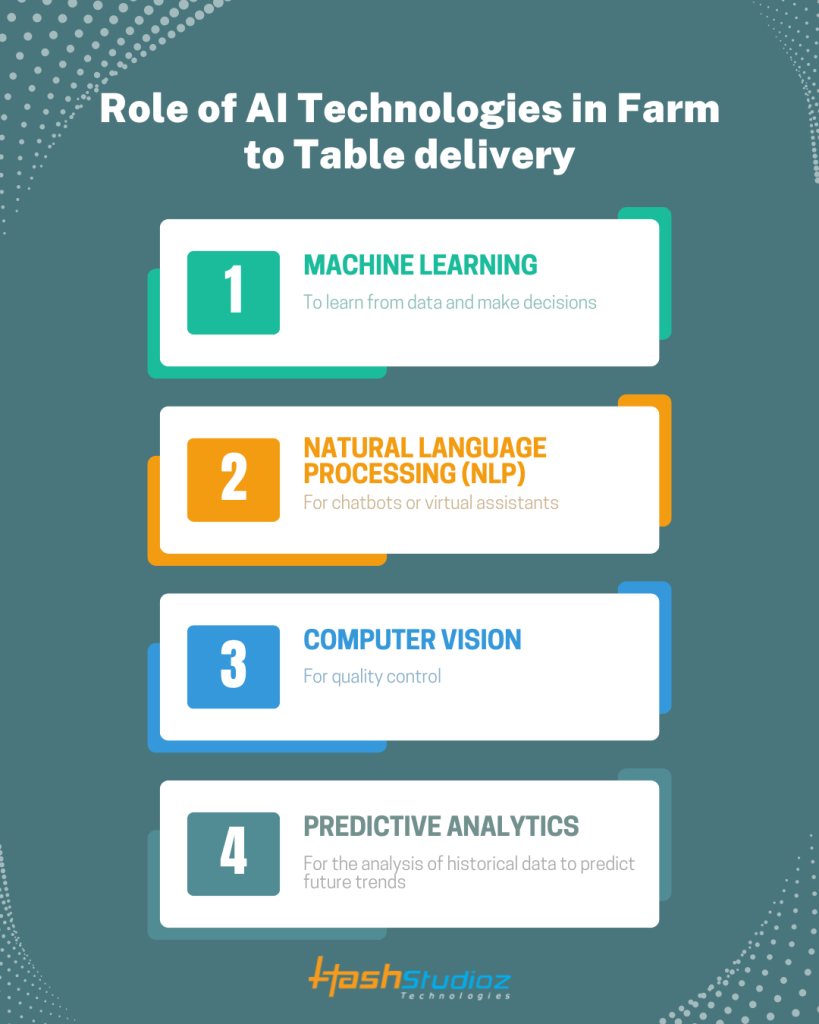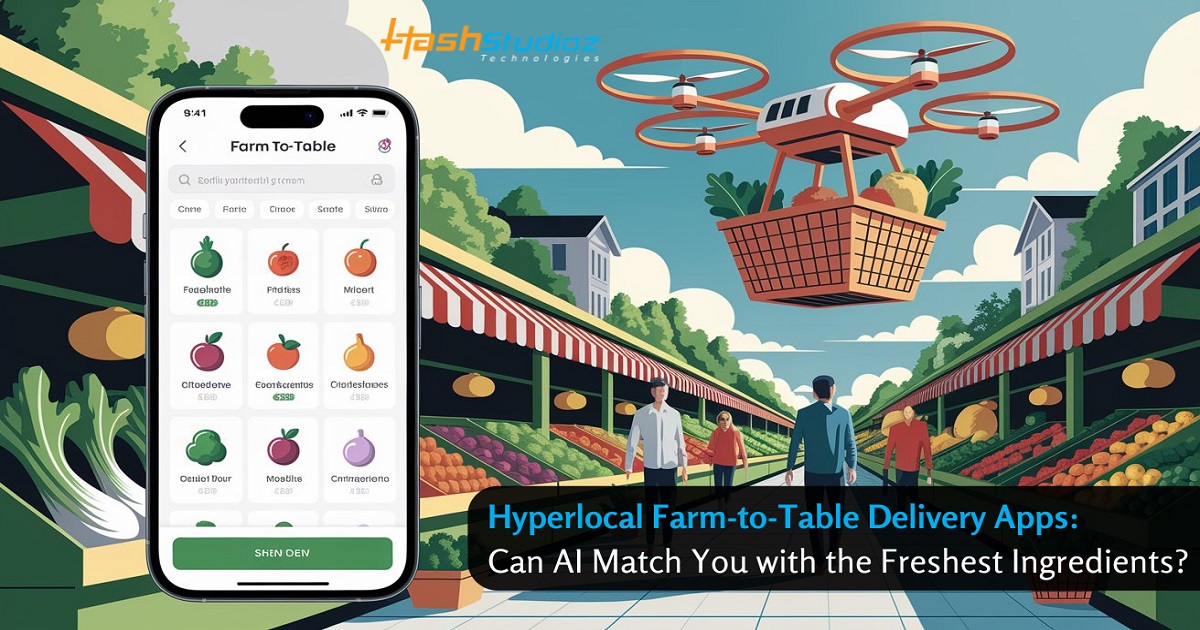Table of Contents
- Introduction
- What Are Hyperlocal Farm to Table Delivery Services?
- The Rise of Hyperlocal Farm to Table Delivery Apps
- The Role of AI in Hyperlocal Delivery
- Key AI Technologies Involved in Farm to Table
- Benefits for Consumers and Farmers
- Challenges and Solutions
- The Future of Hyperlocal Farm to Table Delivery
- Conclusion
Introduction
In recent years, the farm-to-table movement has surged in popularity, with more consumers seeking fresh, local produce and supporting small-scale farmers. In fact, 2022 data from the Specialty Food Association reveals that nearly 40% of consumers are actively seeking fresh, locally sourced ingredients for their meals.
Enter hyperlocal farm-to-table delivery apps. These apps, which connect consumers directly with local farmers and producers, are becoming increasingly popular. But the real game-changer lies in the application of Artificial Intelligence (AI).
What Are Hyperlocal Farm to Table Delivery Services?
Farm-to-table services focus on delivering fresh ingredients directly from local farms. This model benefits both consumers, who receive quality produce, and farmers, who gain a direct sales channel. The hyperlocal aspect refers to a delivery service operating within a specific geographic region, connecting local farms with nearby customers.
Hyperlocal farm-to-table delivery apps help consumers avoid long trips to the supermarket by offering convenient access to fresh, seasonal produce. These apps allow consumers to enjoy high-quality ingredients at their peak freshness while supporting local farmers.
The Rise of Hyperlocal Farm to Table Delivery Apps
The concept of farm-to-table is not new. However, what has changed in the last decade is how these products reach consumers. No longer limited to farmers’ markets or local grocery stores, fresh, organic produce is now just a few clicks away through dedicated delivery apps. These hyperlocal delivery services enable consumers to purchase fresh vegetables, fruits, dairy, and meats sourced from nearby farms, ensuring both quality and sustainability.
What makes these apps different from traditional grocery delivery services is their focus on locality and freshness. For instance, platforms like Farmigo, Good Eggs, and Misfits Market are examples of how the hyperlocal farm-to-table model has been digitally optimized. These apps connect local farms directly with consumers, bypassing the traditional retail supply chain. By cutting out middlemen, these platforms can offer products at competitive prices while promoting the freshness of the produce.
The success of such apps hinges on their ability to maintain an effective supply chain that can quickly respond to demand changes. This is where AI and machine learning come into play, helping to optimize the process and ensure customers get the freshest ingredients as close to the source as possible.
The Role of AI in Hyperlocal Delivery
AI plays a pivotal role in optimizing and scaling hyperlocal farm-to-table delivery systems. The primary advantage of AI is its ability to handle large volumes of data, make predictive analyses, and provide personalized recommendations, all critical for such services to thrive.
- Personalized Recommendations: AI can analyze a consumer’s purchasing habits and suggest products that are likely to interest them. By learning from consumer behavior, these apps can present users with fresh produce based on their past preferences, seasonal availability, and even dietary restrictions.
- Optimized Delivery Routes: AI can help minimize the time it takes for farm-to-table products to reach consumers. Using algorithms, AI can predict the best delivery routes, factoring in variables like weather, traffic conditions, and delivery windows, ensuring that the produce stays fresh and arrives on time.
- Inventory Management: One of the challenges of delivering fresh produce is ensuring that inventory levels align with actual demand. AI can forecast demand, preventing overstocking or understocking and ensuring farmers don’t waste resources growing too much or too little. This can help prevent spoilage and reduce food waste, which is a common issue in the food industry.
- Quality Control: AI can assist in monitoring the quality of products being delivered. For example, AI-powered cameras can inspect fruits and vegetables for blemishes or other signs of spoilage before they are shipped out. This ensures that consumers receive the freshest possible ingredients.
Key AI Technologies Involved in Farm to Table
AI encompasses a wide range of technologies, and many of them are currently being implemented in hyperlocal farm-to-table delivery apps. Below are some key AI technologies playing a role in this evolution.

Machine Learning (ML) in Farm to Table
At the core of AI is machine learning, which allows systems to learn from data and make decisions without being explicitly programmed. Machine learning algorithms help delivery apps understand customer preferences, predict demand, and optimize inventory levels, making the system smarter over time.
Natural Language Processing (NLP) in Farm to Table
Many farm-to-table apps use chatbots or virtual assistants powered by NLP. These systems can interact with customers in real-time, answering questions, helping them place orders, and even providing recipe suggestions based on the ingredients they buy.
Computer Vision
AI-powered computer vision can be used for quality control. Cameras connected to AI systems can scan produce for signs of damage or deterioration, ensuring that only the best quality items are sent to consumers.
Predictive Analytics
This type of AI analyzes historical data to predict future trends. For instance, predictive analytics can help forecast what products will be in high demand during specific seasons, allowing apps to plan inventory accordingly. It can also anticipate how weather conditions, holidays, or events affect demand for specific types of produce.
Benefits for Consumers and Farmers
The combination of farm-to-table delivery apps and AI offers significant benefits for both consumers and farmers.
For Consumers:
- Freshness and Quality: AI ensures that consumers receive the freshest possible ingredients by optimizing delivery times and maintaining quality control checks.
- Convenience: No longer do consumers need to visit farmers’ markets or grocery stores to find locally sourced products. With hyperlocal delivery apps, the farm is just a few taps away.
- Personalized Experience: AI-driven apps can offer customized suggestions based on individual preferences and dietary needs, improving the overall shopping experience.
- Sustainability: By supporting local farms, consumers are contributing to sustainability efforts and reducing the carbon footprint associated with long-distance food transport.
For Farmers:
- Direct Access to Consumers: Farmers benefit from more direct access to customers without the need for middlemen, which means they can earn higher profits on their products.
- Better Demand Forecasting: With AI-driven insights into consumer demand, farmers can plan their crop production more effectively, reducing waste and ensuring they grow the right quantities.
- Increased Efficiency: By using AI to optimize logistics, farmers can streamline their operations, saving time and resources in the process.
Challenges and Solutions
While the potential benefits of AI-powered farm-to-table delivery apps are immense, several challenges remain.
- Data Privacy and Security: Since these platforms collect a lot of personal data, ensuring privacy and security is critical. To mitigate this, companies must adopt robust cybersecurity measures and be transparent about data usage policies.
- Supply Chain Complexities: Managing a hyperlocal supply chain for perishable goods requires precise coordination. AI can help, but it requires constant monitoring and adjustment to ensure quality and efficiency. Investing in strong logistics infrastructure and technology is essential to overcoming this challenge.
- Accessibility for Farmers: While larger farms may have access to advanced technologies, smaller farmers might not. To make AI-driven platforms accessible to all, farm-to-table apps could offer training programs and resources that help farmers utilize these technologies.
- Consumer Trust: Some consumers may be skeptical of AI-driven systems, especially when it comes to food. Educating users on how AI helps ensure freshness and quality while also highlighting the benefits of supporting local farms can go a long way in building trust.
The Future of Hyperlocal Farm to Table Delivery
The future of hyperlocal farm-to-table delivery apps is promising, especially as AI continues to evolve. In the near future, we can expect even more sophisticated AI tools that help reduce food waste, improve sustainability efforts, and create a more personalized experience for consumers. Moreover, as consumer demand for organic, locally-sourced foods continues to rise, these apps will likely expand to offer a broader range of products and services.
Another area where AI can make an impact is in the development of vertical farming. With more farms moving indoors and using technology to optimize production, AI could play a significant role in managing these high-tech farms, ensuring that they produce the right amounts of crops for local consumption.
The integration of blockchain technology to ensure traceability and transparency of food sources will also become more prevalent, enabling consumers to track the journey of their food from farm to table.
Conclusion
AI-powered hyperlocal farm-to-table delivery apps are reshaping the way we think about fresh produce and food delivery. By leveraging advanced AI technologies like machine learning, computer vision, and predictive analytics, these platforms ensure that consumers receive high-quality, locally sourced ingredients efficiently and conveniently. While challenges like data privacy, supply chain management, and accessibility for farmers remain, the future looks bright for AI-driven farm-to-table delivery systems. As this technology continues to advance, consumers and farmers alike stand to benefit from a smarter, more sustainable food ecosystem.
For businesses looking to create or optimize their own farm-to-table delivery app, companies like HashStudioz can provide tailored AI and technology solutions that drive success. Their expertise in AI-driven systems and custom software development ensures that businesses can stay ahead in this rapidly growing market. Whether you’re a farmer, consumer, or tech developer, embracing these innovations will pave the way for a more sustainable and efficient food delivery experience.
Ready to integrate AI into your farm-to-table delivery service? Contact HashStudioz today to get started.

